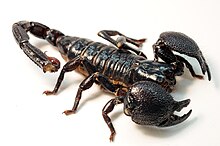Emperor scorpion
| Emperor scorpion | |
|---|---|
 |
|
| Scientific classification | |
| Kingdom: | Animalia |
| Phylum: | Arthropoda |
| Class: | Arachnida |
| Order: | Scorpiones |
| Family: | Scorpionidae |
| Genus: | Pandinus |
| Species: | P. imperator |
| Binomial name | |
|
Pandinus imperator (Koch, 1842) |
|
| External identifiers for Emperor scorpion | |
|---|---|
| Encyclopedia of Life | 5010047 |
The Emperor Scorpion, Pandinus imperator, is a species of scorpion native to rainforests and savannas in West Africa. It is one of the largest scorpions in the world and lives for 6–8 years. Its body is black, but like other scorpions it glows pastel green or blue under ultraviolet light. It is a popular species in the pet trade, and is protected by CITES.
The emperor scorpion (Pandinus imperator) is one of the largest species of scorpion in the world, with adults averaging about 20 centimetres (7.9 in) in length and a weight of 30 g. However, some species of forest scorpions are fairly similar to the emperor scorpion in size, and one scorpion, Heterometrus swammerdami, holds the record for being the world's largest scorpion at 9 inches (23 cm) in length. The large pincers are blackish-red and have a granular texture. The front part of the body, or prosoma, is made up of four sections, each with a pair of legs. Behind the fourth pair of legs are comb-like structures known as pectines, which tend to be longer in males than in females. The tail, known as the metasoma, is long and curves back over the body. It ends in the large receptacle containing the venom glands and is tipped with a sharp, curved stinger. Scorpion stings can be categorized as mild (similar to a bee sting) to severe to humans depending on the species. Most people are not affected by the Emperor Scorpion's sting, though some people may be allergic to scorpion stings in general. Sensory hairs cover the pincers and tail, enabling the emperor scorpion to detect prey through vibrations in the air and ground.
When gravid (pregnant), the body of a female expands to expose the whitish membranes connecting the segments. The emperor scorpion fluoresces greenish-blue under ultra-violet light.
They are known for their docile behavior and almost harmless sting; they do not use their sting to defend themselves when they are adults, however, they may use it in their adolescent stages. They prefer to use their pincers to crush and dismember their prey, their exoskeleton is very sclerotic, causing them to have a metallic greenish black color.
...
Wikipedia
